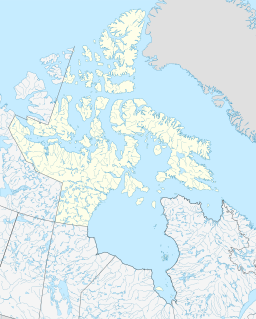Kane Basin
Appearance
(Redirected from Kane Basin (waterway))
| Kane Basin | |
|---|---|
 Kane Basin, Nunavut, Canada. Nunavut Greenland Northwest Territories | |
| Location | Smith Sound / Kennedy Channel |
| Coordinates | 79°04′30″N 73°05′10″W / 79.07500°N 73.08611°W[1] |
| Ocean/sea sources | Arctic Ocean |
| Basin countries | Canada |
| Settlements | Uninhabited |
Kane Basin (Danish: Kane Bassin; French: Bassin (de) Kane) is an Arctic waterway lying between Greenland and Ellesmere Island, Canada's northernmost. It links Smith Sound to Kennedy Channel and forms part of Nares Strait. It is approximately 180 km (110 mi) in length and 130 km (81 mi) at its widest.
It is named after the American explorer Elisha Kent Kane, whose expedition in search of Franklin's lost expedition crossed it in 1854. Kane himself had named it "Peabody Bay," in honor of philanthropist George Peabody, the major funder of Kane's expedition.[2] Currently Peabody Bay is a bay at the eastern side of the basin, off the southwestern end of the Humboldt Glacier in northern Greenland.[3][4]
Further reading
[edit]- Cold Regions Research and Engineering Laboratory (U.S.). Radar Imagery of Arctic Pack Ice Kane Basin to North Pole. Hanover, N.H.: The Division, 1968.
- Hobbs, William Herbert. Discovery and Exploration Within the Area to the West of the Kane Basin. 1939.
- Kravitz, Joseph. Sediments and Sediment Processes in Kane Basin, a High Arctic Glacial Marine Basin. [Boulder, Colo.?]: University of Colorado, Institute of Arctic and Alpine Research, 1982.
- Marentette, Kris Allen. Late Quaternary Paleoceanography in Kane Basin, Canada and Greenland. Ottawa: National Library of Canada, 1989. ISBN 0-315-43760-X
References
[edit]- ^ "Kane Basin". Geographical Names Data Base. Natural Resources Canada. 24 August 2024.
- ^ "KANE, ELISHA KENT". University of Toronto Press. Retrieved 2010-03-28.
A believer in the hypothesis of an open polar sea, he persuaded Grinnell, American financier George Peabody, the United States Navy Department, and several scientific societies to sponsor a second expedition to go north from Baffin Bay to the shores of the "Polar Sea" in search of Franklin. [...] The Advance then proceeded up the west coast of Greenland and into the sound Kane named Peabody Bay (later renamed Kane Basin) where, by the end of August, its northward progress was stopped by the ice.
- ^ Prostar Sailing Directions 2005 Greenland and Iceland Enroute, p. 88
- ^ McGary Oer, Greenland[permanent dead link]

